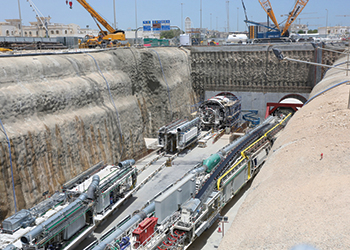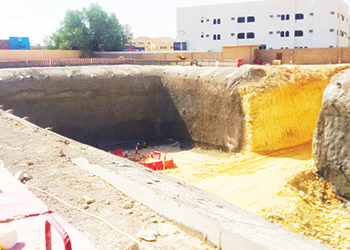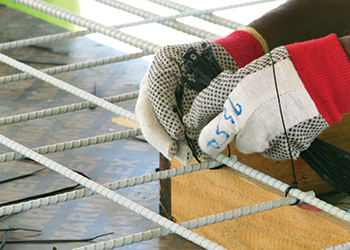
 Doha Metro’s Al Sudan Gold Line underground station Three ... well in progress.
Doha Metro’s Al Sudan Gold Line underground station Three ... well in progress.
The GCC’s ambitious plan to connect through an extensive railway network has seen member states roll out multi-billion-dollar projects.
The Middle East is now host to some of the world’s most ambitious rail and metro projects which are estimated to be worth more than $200 billion.
According to Louis Berger, a US-based architectural and engineering design firm, more than 33,700 km of mainline routes and 3,000 km of new metro lines are planned or under way.
Railways across the GCC in particular are making remarkable progress with Qatar’s and Saudi Arabia’s projects reaching important milestones and Oman inviting companies to design, build and supervise its ambitious rail plans.
Bahrain and Kuwait also have plans to implement railway projects, which are still in the early stages.
Kuwait is spearheading the development of its $7-billion metro. Construction is expected to begin in 2017, and will be divided into many segments in five phases, allowing many contractors to work on different lines in order to complete it in five years.
The 160-km K-Metro, covering three lines and 69 stations – of which 65 per cent will be underground – will be part of a modern transportation system that will contribute to transforming the country into a major financial and trade hub. The project will be built on a build-operate-transfer (BOT) basis.
In addition, Kuwait is developing the Kuwait National Rail Road System project, which will link with the GCC railway network. The estimated $10-billion project will be an integrated rail network with a total length of 511 km of double track.
Oman
Oman has embarked on an extensive railway network spearheaded by Oman Rail, which has issued tenders for four of the nine segments of the 2,135-km rail project. Work on the Oman National Railway Project is expected to start in the second half of this year.
The modern railway network for freight and passengers includes future plans for a high-speed rail.
The ambitious logistical venture will link the vast expanses of the sultanate eventually with the GCC rail network as well as Yemen. The first segment covers a 207-km stretch from Sohar port to Buraimi. The engineering, procurement and construction (EPC) contract for the stretch representing Segment One is expected to be announced in Q3 of this year.
Oman Rail has now floated tenders for pre-qualification of EPC services for an additional 1,207 km of railway infrastructure involving three further segments linking the country’s three maritime gateways at Sohar, Duqm and Salalah with the GCC rail system.
Segments Two, Three and Four cover the distance from Hafeet on Oman’s border with Abu Dhabi all the way down to Salalah in Dhofar Governorate, via Haima and Duqm. Together with Segment One, they represent the strategic backbone of the country’s rail network (see Regional News).
Qatar
Qatar has seen around 20 km of the 113 km of tunnels dug on the Doha Metro, a landmark that clearly highlights the progress of the tunnelling works underneath Doha city, says Qatar Railways Company (Qatar Rail), the company overseeing the construction of the Qatar’s integrated railway network.
Qatar Rail has already received 21 tunnel boring machines (TBMs) assigned for the project from Herrenknecht, the German world market leader in mechanised tunnelling technology. Most of these TBMs are currently operational, with the tunnelling phase expected to be completed by Q2 2017.
The TBMs are a key component in implementing the project; they are a high-tech mechanised alternative to conventional methods of design-and-build mining, drilling and blasting tunnels through everything from soft ground to hard rocks. The Doha Metro is using 7-m diameter TBMs, producing a tunnel with a diameter of 6.7 m.
The metro’s Red Line has launched all TBMs, with tunnelling works progressing according to plan where the accumulative dug of these TBMs has reached 11,880 m for both the north and south sections. In parallel, the Green Line has launched its six TBMs with an accumulative tunnelling of 6,653 m. Similarly, the tunnelling drive on the Gold Line has recorded 150 m so far, which has received its six tunnel-boring machines.
The metro, part of the overall Qatar Integrated Railway programme, is approximately 231 km in length across four lines (Red, Green, Gold and Blue) with an estimated total construction value of $36 billion. Approximately 100 stations are planned along the metro, including two major stations built at Msheireb and Education City.
The metro is being executed in twin stages with Phase One involving a 131-km stretch (63 km underground, 48 km elevated and 20 km at grade) and 48 stations. Phase Two will see the construction of a 100-km track (37 km underground, 53 km elevated and 10 km at grade) with 44 stations. Phase One is on course to open in 2019.
In late February, the Louis Berger Egis Rail Joint Venture was commissioned by Qatar Railways Company to provide project management consultancy services for all elevated and at-grade sections of the project. The joint venture was initially commissioned in August 2012 to provide project management consulting services on the major underground sections, including the Gold line and major stations. In 2013, it was also commissioned to provide independent certification engineer services, which covered early enabling works along with utility diversions.
Work is also in progress on the Light Rail Transport (LRT) project in Lusail, where the main civil works of seven underground stations and all the excavation works have been completed. The LRT project comprises four operating lines, totalling 33 km of network and 37 stations, which include 10 underground stations. It will also be connected to the Doha Metro Red Line North via two main stations.
Meanwhile, a consortium including French industrial groups Vinci and Alstom has signed a €2-billion ($2.72 billion) contract with Qatar Railways Company to build a tram system for the city of Lusail.
Saudi Arabia
Construction has started on the first Riyadh metro tunnel by the Fast consortium led by FCC Construction.
Riyadh governor Prince Faisal bin Bandar activated the first of the two TBMs that will be used to build the Green Line of the metro that will have 11 stations and two connections with the Blue and Red lines.
The scope of the consortium’s work includes the design and construction of the three lines – lines Four (Yellow), Five (Green) and Six (Purple) – which incorporates 25 stations and two buildings for the maintenance and parking of the trains. It also includes the construction of 64.3 km of metro tracks, 29.8 km of viaducts, 26.6 km of underground tracks and 8.2 km of at-grade tracks. Out of the total budget of €16.3 billion ($17.78 billion), around €6 billion ($6.5 billion) are for the works on lines Four, Five and Six. In addition, 69 automatic and driverless trains will be brought in to provide service to the three lines.
“FCC will be using three TBMs with a diameter of almost 19 m, to excavate full tunnel sections,” says a spokesman for FCC. “The Dhafrah TBM has already begun excavation of the first 12.9-km tunnel between the Riyadh Air Base and King Abdul Aziz Historical Centre, and is expected to cover an average of between 75 and 100 m per week.”
In total, seven TBMs will be used to finish the six-line metro in Riyadh, the world’s biggest underground system in construction, with 85 stations covering 176 km.
The consortium began Stage One of its works in April with the excavation of the Line Four (L4) G1 station at Riyadh’s King Khaled International Airport, one of the stations on Line Four which will link the King Abdulla Financial District to the capital’s airdrome. Construction work has begun on the L4 viaducts on this line.
Work is expected to be completed in 2018 with Fast – a consortium comprising FCC along with Samsung, Alstom, Strukton, Freyssinet Saudi Arabia, Typsa, Atkins and Setec – employing around 15,000 workers.
The other lines of the metro are being built by the BACS consortium which is responsible for lines One and Two, totalling 63.3 km under a $9.45-billion contract and the ArRiyadh New Mobility consortium, which is handling line Three – the longest at 40.7 km – under a $5.21-billion deal.
Apart from the Riyadh Metro, metro systems are also planned for Makkah and Jeddah.
Meanwhile, trial operations have begun of the first completed section of the Haramain High-Speed railway line. The line will connect Madinah to Jeddah and Makkah.
Another long-awaited project is the Saudi Landbridge, a 480-km high-speed railway line between Riyadh and Dammam. Consultrans was selected in September 2014 to conduct a feasibility study on the construction of the project.
UAE
Work is well in progress on the UAE’s 1,200-km national freight and passenger railway network, which is being delivered in three key stages by Etihad Rail, its developer and operator.
The project is progressing well with Stage One, which connects Shah and Habshan to the Ruwais port, recently completed and preparations under way for work to start on the 628-km Stage Two line.
The UAE government has released Dh700 million ($190.5 million) as an initial allotment to start construction on Phase Two. This phase connects the 264-km Phase One to Musaffah and Khalifa Port in Abu Dhabi, Jebel Ali in Dubai and to the Saudi and Omani borders.
Stage Three, which will stretch 279 km in length, will focus on transporting bulk commodities in the Northern Emirates, according to the rail network operator.





















_0001.jpg)


.jpg)
















.jpg)








.jpg)




